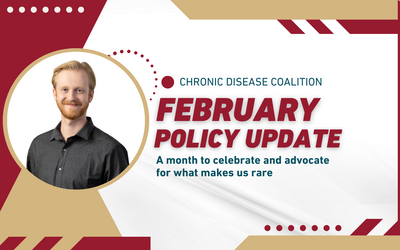
By Nathaniel Brown, director of advocacy
To some, February 29 is a day to celebrate something that feels rare — an extra day in the year.
To others, especially in our community, it’s a day to celebrate something that is much more common that one may think: the lives 25-30 million Americans who live every day with a rare disease.
So, happy Leap Day AND happy Rare Disease Day! While there’s been a lot of great movement on legislation this past month regarding step therapy reform, copay accumulator bans, Medigap expansion and other priority areas, we felt like today was a perfect excuse to focus solely on the progress we’ve seen so far this year for patients living with rare diseases.
At the state level, we’ve been hard at work advocating for new Rare Disease Advisory Councils (RDACs) in Vermont, Arizona, Oklahoma, and California. Because legislators and state agencies aren’t experts on every single issue — especially those impacting rare disease patients — they often rely on task forces of experts or affected citizens.
RDACs are necessary to ensure all perspectives are heard and issues are given the thought and consideration they deserve by a diverse group of stakeholders — including patients. Together, they recommend prescriptive solutions to issues that impact rare disease patients.
If you’re curious about these groups, check out our Ambassador Christina Thielst’s guest blog on our website about her experience serving on Nevada’s RDAC.
In Washington state, there’s a bill still in committee that would establish an ombudsman within the Washington Health Care Authority to solely help rare disease patients navigate treatment and insurance.
In Colorado, we’ve been working with a coalition to advance a bill that would remove rare disease treatments from the purview of a Prescription Drug Affordability Board (PDAB), which has the authority to set price controls on treatments. While that sounds like a good thing, limiting how much a drug can cost is a strong disincentive to continue manufacturing that drug — and rare disease treatments are already notoriously risky investments.
Read more about PDABs and why patients should care about them in one of our recent blog posts.
Finally, at the federal level, we have a request: Take one minute and send a message to your elected representatives in support of the ORPHAN Cures Act. This bill would protect treatments (for more than one rare disease) from government price negotiations, which have been proven to disincentivize research and development of new treatments. This is something the rare disease community already struggles with daily.
We have an obligation to the next generation of patients to encourage the development of the next generation of treatment — and the ORPHAN Cures Act does just that.
While the last day in February is always Rare Disease Day, our advocacy for patients navigating these conditions extends throughout the year. 2024 will be a monumental year for our community and we can’t wait to see the progress we make together.